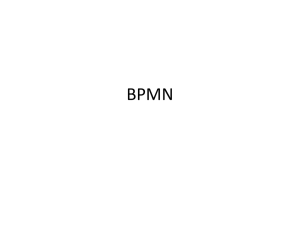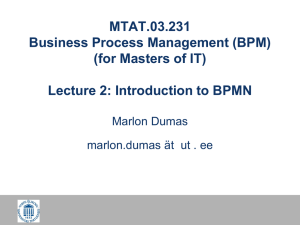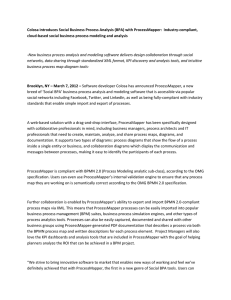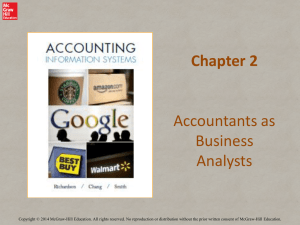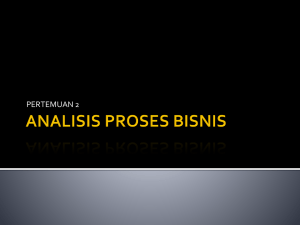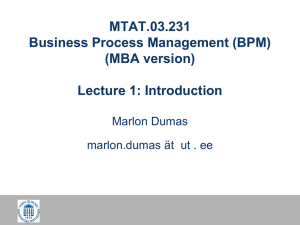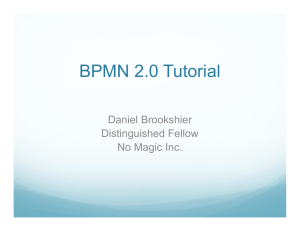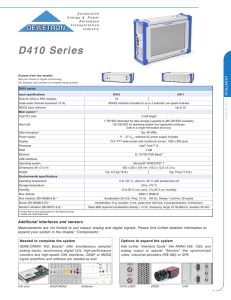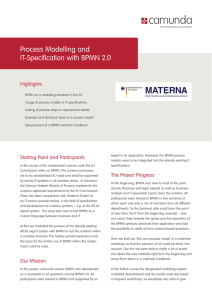BPMN Process Modeling: Essentials & Notation
advertisement
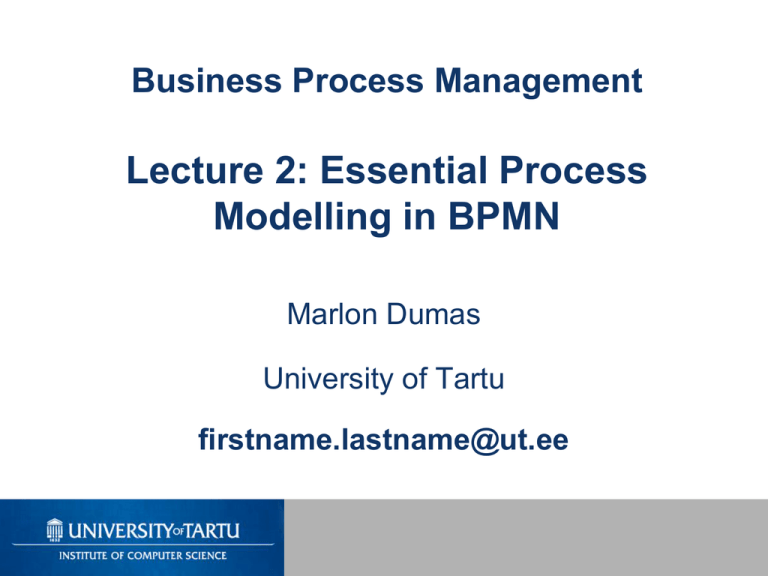
Business Process Management Lecture 2: Essential Process Modelling in BPMN Marlon Dumas University of Tartu firstname.lastname@ut.ee Business Process Lifecycle 2 Purposes of Process Modeling Organizational Analysis “AS IS” Process Models Business-level Models Process Metrics Process Enactment & Monitoring Process Implementation Executable Process Models Process Evaluation Target Values Measures for Improvement “TO BE” Process Analysis & Design Process Models Communication, simulation, activitybased costing… Detailed Models including Data types, conditions, data mappings, fault handling… 3 Business Process Modeling Notation (BPMN) • OMG Standard (nowadays version 2.0) • Both for business-oriented and executable models • Supported by a wide range of tools, e.g. – – – – – – – Bizagi Process Modeller (free) Signavio (http://www.signavio.com/) - SaaS Oracle BPA – “kind of free” ARIS – very sophisticated, the opposite of free Logizian MS Visio Paper and pen! - No excuse not to start 4 BPMN from 10 000 miles… • A BPMN process model is a graph consisting of four types of elements (among others): 5 Order Management Process in BPMN First Try Reject order Check stock availability Send invoice Confirm order Ship goods 6 A little bit more on Gateways … • Exclusive Decision (XOR-split) / Merge (XOR-join) – Indicates locations within a business process where the sequence flow can take two or more alternative paths. – Only one of the paths can be taken. – Depicted by a diamond shape that may contain a marker that is shaped like an “X”. • Parallel Fork (AND-split) / Join (AND-join) – Provide a mechanism to synchronize parallel flow and to create parallel flow. – Depicted by a diamond shape that must contain a marker that is shaped like a plus sign. 7 Revised Order Management Process 8 Beware: Beginner’s Mistake… 9 BPMN Exercise: Simplified Insurance Claim Registration When a claim is received, we first check if the claimant has a valid insurance policy. If not, the claim is rejected and the claimant is informed. Otherwise, we assess the severity of the claim. Based on the outcome (simple or complex claim), we send the corresponding form to the claimant. Once the form is returned, we check it for completeness. If the form is complete, we register the claim in the Claims Management system and the evaluation of the claim may start. Otherwise, we ask the claimant to update the form. When we receive the updated forms, we check them again and continue. 10 Guidelines: Naming Conventions 1. Give a name to every event and task 2. For tasks: verb followed by business object name and possibly complement – Issue Driver Licence, Renew Licence via Agency 3. For message events: object + past participle – Invoice received, Claim settled 4. Avoid generic verbs such as Handle, Record… 5. Label each XOR-split with a condition – Policy is invalid, Claim is inadmissible 11 Poll: Which model do you prefer? 12 One more guideline… • Model in blocks – Pair up each AND-split with an AND-join and each XOR-split with a XOR-join, whenever possible – Exception: sometimes a XOS-split leads to two end events – different outcomes (cf. order management example) 13 Process Modelling Viewpoints Organization Who? Lanes & Pools What? Tasks Events When? Flows Gateways Which? Data / Materials Data Objects, Stores 14 Organizational Modelling in BPMN • Pools – Independent organizational entities, e.g. • Customer, Supplier, East-Tallinn Hospital, South Eastern Clinic • Lanes – Classes of resources within the same organizational and collaboration space • Sales Department, Marketing Department • Roles: Clerk, Manager, Engineer 15 Running Example with Pools and Lanes 16 BPMN Exercise: Lanes, Pools • Claims Handling process at a car insurer A customer submits a claim by sending in relevant documentation. The Customer Service department checks the documents for completeness and registers the claim. The Claims Handling department picks up the claim and first checks the insurance policy. Then, an assessment is performed. If the assessment is positive, a garage is phoned to authorise the repairs and the payment is scheduled (in this order). In any case (whether the outcome is positive or negative), an e-mail is sent to the customer to notify the outcome. 17 Data in BPMN Data Object Data Store • Data Objects: logical data units required, created or modified by activities. – Input and output of a process activity • Data stores: containers of data objects that need be persisted beyond the duration of a process instance • Associations are used to link artifacts Directed association such as data objects and data stores with flow objects (e.g. activities). Undirected association 18 Running Example with Data Object 19 BPMN Exercise 3: Artifacts When a claim related to a major car accident is evaluated, a clerk first retrieves the corresponding car accident report from the Police Reports database. If the report is retrieved, it is attached to the claim file. The claim file and the police report serve as input to a claims handler who calculates an initial claim estimate. Then, an “action plan” is created based on a “checklist”. Based on the action plan and the initial claims estimate, a claims manager negotiates a settlement with the customer. After this negotiation, the claims manager makes a final decision, updates the claim file to record this decision, and sends a letter to the claimant to inform him/her of the decision. Please depict all relevant documents in the model. 20 BPMN Main Elements - Recap Swimlanes Pool Connections Message Lane Association Flow Flow Elements Artifacts Text Annotation Activity Gateway Event Data Object Data Store 21 BPMN Flow Elements – Recap Start Event Task End Event Flow AND-Join c ~c AND-Split XOR-Decision XOR Merge 22 What’s wrong with this model? X 23 BPMN Gateways Exclusive (XOR) Parallel (AND) Inclusive (OR) • Exclusive decision • Parallel split take all branches • Parallel join proceed when all incoming branches have completed • Inclusive decision take one or several branches depending on conditions • Inclusive merge proceed when all active incoming branches have completed take one branch • Exclusive merge Proceed when one branch has completed 24 Example: OR gateways 25 How can we fix this model? X 26 Exercise Model the following fragment using OR gateways: When a claim is received, it is registered. After registration, the claim is classified leading to two possible outcomes: simple or complex. If the claim is simple, the policy is checked. For complex claims, both the policy and the damage are checked independently. Check also the self-test quiz available at: http://www.proprofs.com/quizschool/story.php?title=essentials-of-process-modeling 27

